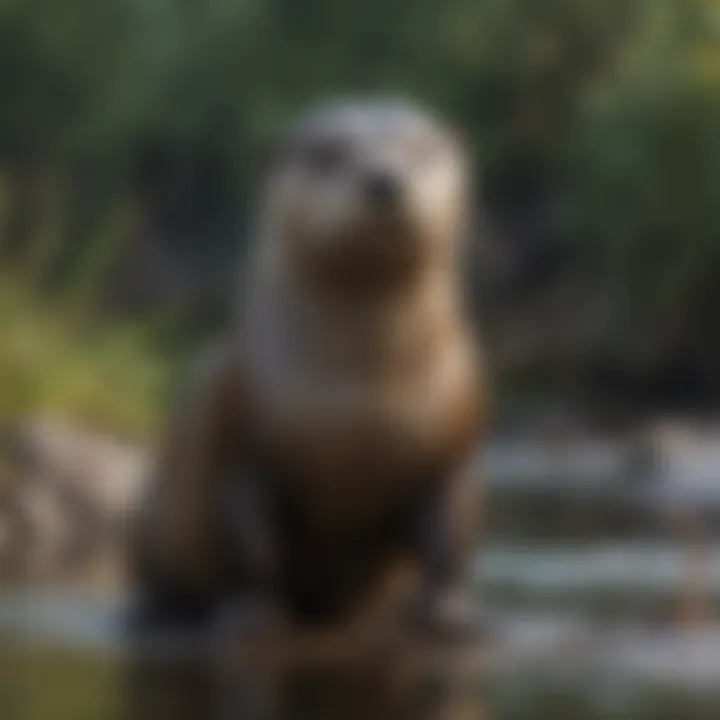Exploring the Size Characteristics of River Otters


Overview of the Topic
River otters are captivating creatures that inhabit various aquatic ecosystems across North America. Their physical dimensions, while seemingly straightforward, are indicative of an array of biological and ecological factors. Understanding the size characteristics of these mammals helps in appreciating their role within their habitats and can inform conservation efforts.
Measuring anywhere from 2 to 5 feet in length, river otters exhibit variance not just based on age and sex but also on regional adaptations. The size and weight of river otters have profound implications that influence their hunting techniques, territory sizes, and reproductive success. Larger individuals may be better suited for specific ecological niches, while smaller otters may take advantage of different food sources or living spaces.
Background Information on the Significance of the Topic
As apex predators within their environments, river otters play a critical role in maintaining the balance of their ecosystems. Their physical dimensions influence their ability to hunt and evade predators, which in turn affects prey populations and overall biodiversity. By examining the physical characteristics of river otters, we can uncover deeper insights into their behaviors and the ecological dynamics at play.
Analyzing size characteristics across subspecies sheds light on evolutionary adaptations. It allows researchers and wildlife enthusiasts to understand how various environmental pressures shape the biology of river otters. This information is vital not only for the species themselves but also for conservation professionals working to preserve wetland habitats and the aquatic life within them.
With their fascinating adaptability and ecological importance, river otters are more than just charming mammals; they are integral components of their ecosystems. Understanding their physical dimensions is crucial for informed conservation practices and effective wildlife management strategies.
Foreword to River Otters
The study of river otters is not only about understanding a single species; it opens a window into the delicate balance of aquatic ecosystems. River otters, with their playful behavior and skilled hunting abilities, play a significant role in their habitats. Recognizing their size and physical characteristics is crucial for various reasons, including ecological management and species conservation. The size of river otters can influence their predatory behaviors and interactions with other species, which underscores the relevance of this topic.
Basic Overview of River Otters
River otters belong to the family Mustelidae, which includes other carnivorous mammals. These creatures are dexterous and versatile, enabling them to thrive in both aquatic and terrestrial environments. Generally, river otters are known for their sleek bodies, which aid in swimming. Their fur is dense and waterproof, a trait essential for maintaining body heat in cold waters. Typically, adult river otters measure between 26 to 42 inches in length, including their tail, which contributes to their agile swimming.
River otters are distributed across North America, from the Arctic regions to the southern passes. They usually inhabit rivers, lakes, and coastal areas. In terms of social structure, river otters are often seen in groups called rafts, which reflect their social behavior. These animals primarily feed on fish, crustaceans, and small mammals, showcasing their adaptability in diet.
Significance of Size in Aquatic Mammals
The physical dimensions of aquatic mammals, including river otters, are essential to understanding their ecological roles. Size can determine feeding efficiency and predator-prey dynamics. Larger otters may have advantages in hunting larger prey, potentially shape the distribution of fish and other aquatic animals. Additionally, body size can influence energy expenditure during foraging and swimming.
Furthermore, the variation in size among different subspecies can reflect environmental conditions. For example, otters living in areas with abundant food sources may grow larger than those in less favorable habitats. This relationship between size and environment illustrates the critical balance that must be maintained in ecological studies. Investigating these size dynamics ensures that conservation efforts can be aligned with the needs of the species and their habitats.
Physical Characteristics of River Otters
The physical characteristics of river otters play a crucial role in their ecological success and adaptability. Understanding these traits helps in appreciating how they interact with their environment, their behavior, and their role in the ecosystem. Significant elements of their physical makeup include their size, shape, and weight, all contributing to their survival in aquatic settings. These characteristics also dictate how river otters hunt, reproduce, and interact with other species. This section aims to delineate the average size metrics and weight range of river otters, providing a detailed examination of these attributes.
Average Size Metrics
River otters exhibit a notable variation in size, primarily influenced by their geographic location and subspecies. Generally, adult river otters measure between 3 to 4.5 feet in length, not including the tail. Tails typically add another 12 to 16 inches, which enhances their swimming capability. Most adult otters stand about 1 to 2 feet tall when on all fours.
In terms of their body structure, river otters possess a long, streamlined shape that aids in swimming. Their limbs are short but strong, enabling them to maneuver efficiently through water. Additionally, their webbed feet work to their advantage, allowing for quick propulsion through aquatic environments. These dimensions are critical for identifying their habitat choices and behavioral patterns. This understanding of size can reveal how they fit within the food chain and their predatory strategies.
Weight Range
Weight is another vital metric when discussing river otters. On average, they weigh between 50 to 100 pounds, depending on individual factors such as sex, age, and overall health. Males tend to be larger and heavier than females, a common trait in many species.


Despite the variations in weight, river otters are built to be versatile hunters. Their weight contributes to their buoyancy and ability to navigate streams and rivers while hunting for prey. Besides, their robust bodies help them maintain energy levels required for chasing after fish, crustaceans, and small mammals, integral parts of their diet.
"Understanding these weight ranges enhances our insight into their role as predators in ecosystems, influencing how they engage with both prey and competitors."
Ultimately, the average size metrics and weight range of river otters are fundamental to their survival. These physical characteristics not only affect their behavior but also have broader implications for their interactions within their ecosystems, making them an essential focus for conservation efforts regarding these fascinating mammals.
Regional Variations in Size
Understanding regional variations in the size of river otters is crucial for grasping how these creatures adapt to their environments. Size can directly influence their survival strategies, foraging behaviors, and interactions with ecosystems. By examining multiple subspecies across different geographical regions, we can appreciate the diverse adaptations river otters have developed in response to environmental pressures.
Subspecies Overview
River otters belong to the Lutra canadensis species, which has several recognized subspecies. Geographic separation has led to distinct characteristics among these groups. For instance, otters in the northern regions often exhibit larger body sizes compared to their southern counterparts. This size discrepancy may relate to the habitats each subspecies occupies. Studies indicate that colder climates tend to favor larger sizes. Larger bodies can store more fat, an essential trait for thermal regulation in harsh conditions.
Some prominent subspecies include:
- Lutra canadensis canadensis - found in Canada and parts of the northern United States.
- Lutra canadensis nairnsi - typically located in the southern United States.
- Lutra canadensis iowensis - primarily found in the Midwest.
These variations highlight how adaptations are crucial for survival. Such differences also influence breeding patterns and social structures, further complicating the overall picture of river otter ecology.
Geographical Factors Affecting Size
Geographical factors play a significant role in determining the size parameters of river otters. Elements such as climate, habitat type, and prey availability directly impact their growth and weight. For instance, marine environments with abundant food sources often support larger otter populations than freshwater locations with limited resources.
Some key geographical factors include:
- Climate: Colder regions like Canada support larger otters due to the need for fat reserves.
- Habitat type: River otters in coastal areas often have access to a diverse diet that promotes larger body sizes compared to those in inland rivers.
- Prey availability: Regions with plentiful fish and crustaceans allow otters to grow larger due to enhanced nutrition.
"Size variations in river otters reflect their ecological adaptability and highlight the importance of conserving diverse habitats."
In essence, recognizing the impact of geographical factors provides deeper insights into river otter biology. Understanding the relationships between size and environmental conditions is essential for effective conservation strategies and managing ecosystems where these otters reside.
Comparison with Other Mustelids
In studying river otters, it is essential to examine their physical dimensions in relation to other members of the mustelid family. Mustelids, which include species such as weasels and badgers, display significant diversity in size and morphology. Analyzing these differences not only enriches our understanding of river otters but also highlights ecological roles and evolutionary traits within the family. These comparisons can provide insight into how size influences behavior, hunting strategies, and habitat preferences among these mammals.
Comparison with Weasels
Weasels are notably smaller than river otters. Typically, weasels range between 14 to 24 inches in length, while river otters average around 24 to 36 inches. This size disparity influences their ecological roles. Weasels are known for their agility and ability to hunt smaller prey. By contrast, river otters, with their larger size, engage in foraging for aquatic prey, which includes fish and crustaceans. The larger body size also offers river otters advantages in terms of thermoregulation in colder waters, giving them a competitive edge in their habitats.
In terms of weight, river otters weigh significantly more than weasels. Adult river otters can weigh between 50 to 100 pounds, while weasels usually range from 1 to 4 pounds.
"Weight not only affects physical prowess but also defines the dietary needs and adaptability of species within aquatic environments."


This considerable weight difference leads to distinct nutritional requirements and influences behavior. River otters often travel in larger social groups compared to the typically solitary nature of weasels.
Comparison with Badgers
Badgers exhibit different characteristics when compared to river otters. Badgers are generally heavier than weasels but still lighter than river otters. For example, a badger can weigh between 15 to 35 pounds and is about 20 to 34 inches long. While similar in length to river otters, the badger's bulk is more grounded, allowing them to dig more efficiently than river otters.
Badgers primarily thrive on terrestrial environments. They are known to hunt insects, smaller mammals, and even vegetation. In contrast, river otters are carnivores that are highly adapted for swimming, showcasing their streamlined bodies and webbed feet that facilitate agile movement in water. The difference in dietary habits is a direct result of their respective sizes and habitats, showcasing the diversity within the mustelid family.
Moreover, river otters have evolved features such as a longer tail that aids in their swimming ability whereas badgers have thickset bodies that provide protection against predators.
The studies of river otters and their mustelid relatives unveil critical conservation insights. Recognizing the differences in size and behavior among mustelids contributes to developing effective strategies aimed at protecting all species in the family, as their survival hinges on understanding the interconnectedness of their sizes, ecological roles, and habitat requirements.
Growth Patterns and Lifespan
Understanding the growth patterns and lifespan of river otters is crucial for comprehending their overall biology and ecology. Growth phases significantly influence their size, behavior, and adaptability to environments. Furthermore, the lifespan of river otters affects their role in ecosystems and conservation efforts. By examining these aspects, we can gain insights into their health, population dynamics, and conservation status.
Growth Phases in River Otters
River otters undergo distinct growth phases throughout their lives, which impact their physical dimensions and behavior. At birth, kits are small and helpless, depending entirely on their mothers. They start with a weight of about 200 grams and are blind and deaf. In the first few weeks, intense growth occurs as they gain weight rapidly, primarily due to nursing.
As they reach around two months, kits begin to explore their environment. During this period, their eyes open, and they develop crucial swimming skills. Their weight can increase dramatically during these early months, reaching approximately 3 kilograms by the time they are weaned. This rapid growth is essential for survival, as they learn to hunt and forage alongside their mothers.
Around six months old, river otters enter a stage of semi-independence. They still rely on parental guidance but start developing their own hunting strategies. Their growth rate begins to stabilize as they transition into adulthood. By about one year of age, most river otters reach sexual maturity, but they continue to grow in size until around two years. Adult males typically grow larger than females, which reflects their role in territoriality and mating.
Average Lifespan and Its Impact on Size
The average lifespan of river otters in the wild is generally between 7 to 10 years. However, some individuals can live longer in captivity, often reaching up to 15 years. Lifespan is a significant factor that influences the size and health of river otters.
As river otters age, their growth slows, and their physical dimensions become more stable. Older otters tend to exhibit larger body sizes, which can affect their predatory capabilities and interactions with other species. Larger otters may have an advantage when it comes to hunting for larger prey or defending their territories, which can be vital for their survival.
A longer lifespan can also lead to accumulated knowledge and experience in foraging and behavior, enhancing their chances of thriving in competitive environments. Moreover, understanding their lifespan helps in conservation efforts, as protecting habitats and ensuring sufficient food can improve survival rates.
In summary, the growth patterns of river otters reveal their adaptability during various life stages, while their average lifespan highlights the importance of size in ecological interactions.
Focusing on these dimensions ultimately informs conservation strategies by helping to recognize the factors that support the health and viability of river otter populations.
Ecological Significance of Size
The size of river otters plays a critical role in their ecological niche. Understanding this significance helps to illustrate how these animals fit into their environments. Size can influence various factors, such as hunting strategies, territory dynamics, and even social behavior within otter populations.
The physical dimensions of river otters are not merely statistical figures; they affect their ability to adapt and thrive in specific habitats. Larger otters, for instance, might have advantages in predatory activities, allowing them to tackle larger prey. This can lead to a cascading impact through the ecosystem. When predation dynamics shift, it can affect the population sizes of species lower on the food chain.
Predatory Role and Size


River otters, being carnivorous mammals, rely heavily on their size to exert influence as predators. Their size aids in the capture of fish, amphibians, and small mammals. Larger river otters can dive deeper and navigate swiftly through water, enhancing their hunting capabilities. Through the process of natural selection, size can directly correlate with successful feeding habits and survival rates.
Not only does size affect hunting success, but it also influences the dietary preferences of river otters. Increased size allows for a broader diet. This variation can contribute to the overall health of river otTer populations, especially in fluctuating environments.
"Size serves as a decisive factor in the life of river otters, affecting predation, foraging strategies, and interactions with their environment."
Community Interaction with Other Species
River otters do not live in isolation. Their size impacts how they interact with various species within their ecosystem. This includes both competitors and prey. As social creatures, they often share habitats with other aquatic mammals, such as beavers and muskrats. In these scenarios, the size of the river otter can determine competitive hierarchies and resource allocation.
Also, a larger size may offer river otters certain advantages in territorial disputes. When establishing territories, larger otters may intimidate or outcompete smaller mammals, thus securing more resources for themselves.
On the flip side, their interplay with prey species nuances relationships in nature. A well-sized otter population can maintain the balance by controlling fish populations, which can prevent overpopulation and subsequent ecological degradation.
In summary, understanding the ecological significance of size is crucial. This comprehension provides insights into river otters' roles in their natural habitats, revealing the intertwined threads of life that characterize their existence.
Conservation Aspects Related to Size
The conservation of river otters is intimately linked to their physical dimensions. Size plays a pivotal role in their survival, influencing not just their physical adaptations but also their ecological niche. Understanding the dimensions of river otters can guide effective conservation strategies. This is crucial as environmental changes increasingly threaten their habitats.
Effects of larger otter populations can be indicative of healthy ecosystems. When river otter sizes decrease, it may suggest underlying issues in their habitat. Conservationists must be attuned to these indicators as they design restoration programs.
Key aspects to consider include:
- Habitat Quality: Availability of adequate prey sizes affects otter growth. Smaller otters might struggle in environments where larger prey are scarce.
- Genetic Diversity: Populations that shrink in size may experience reduced genetic variability. This diminishes adaptability to changing conditions, making it harder for otters to thrive.
- Human Impact: Urbanization and agriculture can lead to habitat fragmentation. Understanding how size variation affects adaptability can foster more sustainable land-use practices.
"Conservation efficacy often hinges on understanding the nuanced relationship between species sizes and their environments."
Impact of Environmental Changes on Size
Environmental changes pose a significant threat to river otters and can directly affect their size. Climate change, pollution, and habitat destruction are leading factors that can impact otter populations. Alterations in water quality can affect prey availability, influencing otter growth rates and size metrics.
Factors such as temperature fluctuations can alter the breeding patterns of otters. In regions facing severe pollution, otters may experience stunted growth due to insufficient or contaminated food resources. Changes in water levels can also affect the habitats that support river otters, altering their foraging efficiency and health.
Conservation Initiatives Focused on Size and Habitat
Conservation initiatives need to be multi-faceted, addressing both habitat preservation and the size dynamics of river otters. Successful programs often involve:
- Monitoring Populations: Regular assessments of otter sizes can provide valuable data on their health and the viability of ecosystems.
- Restoration of Habitats: Efforts to restore wetlands and rivers can increase the availability of food sources and suitable living environments, supporting optimal otter growth.
- Collaboration with Local Communities: Engaging locals in conservation efforts can foster a better understanding of otters’ ecological role and the significance of their size dynamics.
Ending
Summary of Size Characteristics
River otters typically range from 50 to 100 cm in length, with an average weight of between 5 to 14 kg, depending on their environment and subspecies. This variability in size is notably influenced by factors such as habitat availability and food resources. One key takeaway is that the larger otters often have greater access to a diverse array of prey, reflecting their adaptability as opportunistic hunters. This dimensioning contributes to their role in the aquatic food web, effectively positioning them as both predators and prey within their ecological niche.
Final Thoughts on River Otter Size and Ecology
The size of river otters informs much more than just their physical presence in a habitat. It directly relates to their ecological interactions, predatory skills, and adaptation strategies. Understanding these size attributes enables conservationists to develop targeted initiatives. Effective conservation efforts hinge upon recognizing how size influences river otters’ behaviors and adaptations. In the broader scope, the study of their physical dimensions allows for a more nuanced comprehension of environmental health, emphasizing why river otters are important indicators of aquatic ecosystem well-being.



